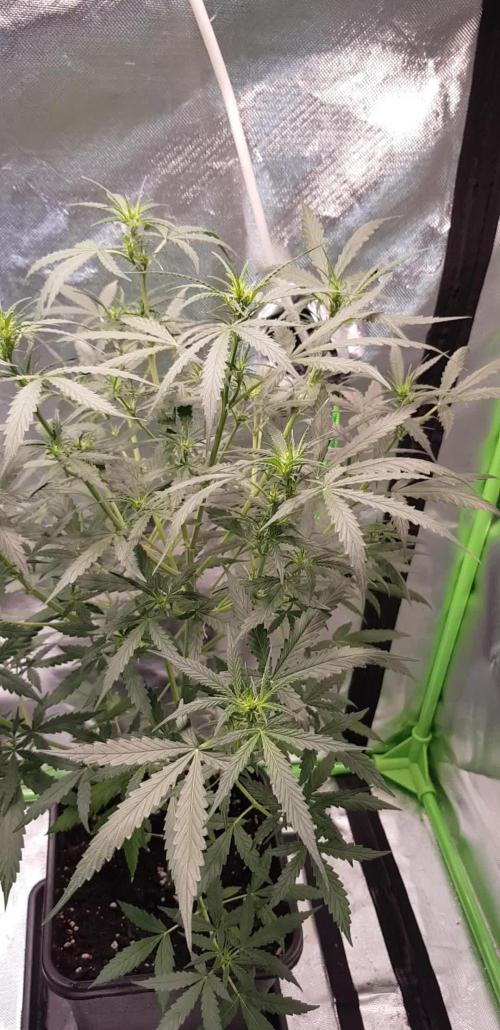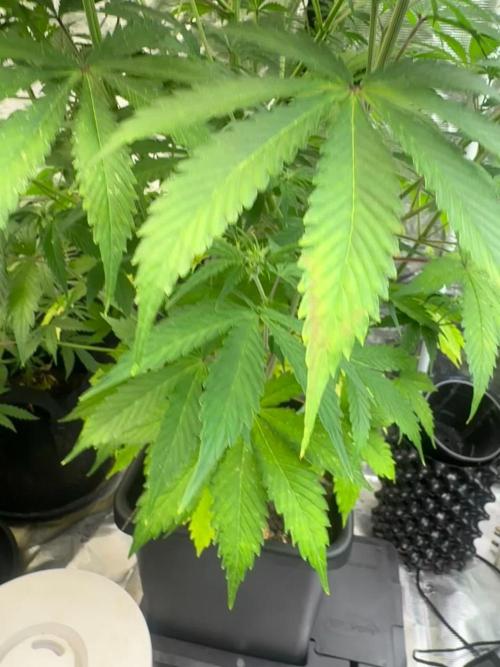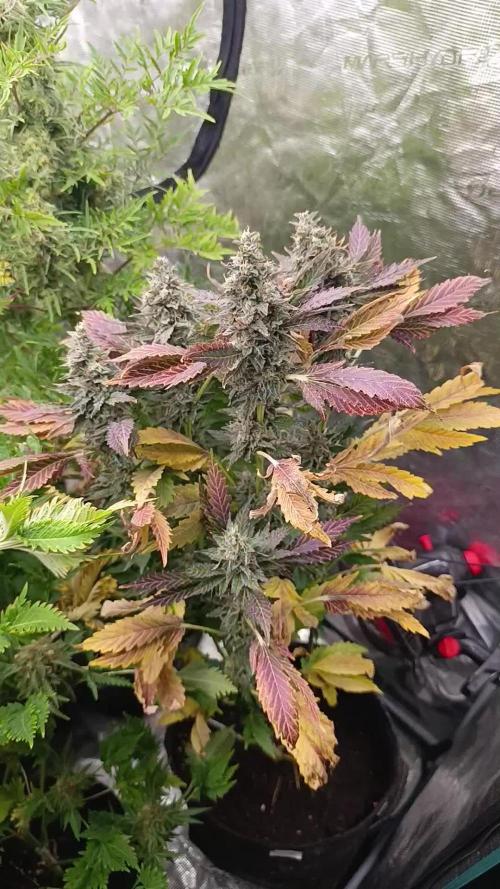The Grow Awards 2026 🏆 































Likes
8
Share


@GERGrowDesigns
Follow
Welcome to Flower Week 1 of Divine Seeds Auto Big Demon
I'm excited to share my grow journey with you all as part of the Divine Seeds Autoflowering Competition 2025. It's going to be an incredible ride, full of learning, growing, and connecting with fellow growers from all around the world!
For this competition, I’ve chosen the Feminized Automatic strain: Big Demon
Here’s what I’m working with:
• 🌱 Tent: 120x60x80
• 🧑🌾 Breeder Company: Divine Seeds
• 💧 Humidity Range: 90
• ⏳ Flowering Time: 8W-10W
• Strain Info: 21-23%THC
• 🌡️ Temperature: 26
• 🍵 Pot Size: 0.5l
• Nutrient Brand: Narcos
• ⚡ Lights : 200W x 2
A huge thank you to Divine Seeds for allowing me to be a part of this amazing competition and Sponsoring the Strains. Big thanks for supporting the grower community worldwide! Your genetics and passion speak for themselves!
I would truly appreciate every bit of feedback, help, questions, or discussions – and of course, your likes and interactions mean the world to me as I try to stand out in this exciting competition!
Let’s grow together – and don’t forget to stop by again to see the latest updates!
Happy growing!
Stay lifted and stay curious!
Peace & Buds!
Likes
19
Share


@Kagesan
Follow
A new week begins.👋
Somehow I missed the moment to put down the lady with LST during the last week. Now the trunk has become so firm that I no longer dare to do so.
Processing
Likes
7
Share


@GanjaFarmar
Follow
So heres the heavyweight Fast and vast. Id say im abit disappointed for the false advertisement on the heavyweight seeds range. It states that in good conditions the plants will be ready in 8-9 weeks with outstanding yileds. But fingers crossed, i cant talk big. Never know what these will produce!
Day 35 from seed now and it’s already showing its pre flowers. I will update week 6 on tuesday!
One Love
Likes
75
Share


@Dedon
Follow
The screen is almost full :D,
Today is the first 12/12 day, everythings seems to be OK, some leafs are yellow on the edge, but i guess it was because pH was fluctuating a lot. New leaf are ok, so i am not worry about that.
See you next week for update ;)
Edit : i add some temperature screenshot, we can notice when i change the water ^^^today for with new nutrient and yesterday to clean root and tank with FloraKleen ( 20ml for 10L )
Edit : 8/11 cut many leafs to expose buds to light
Likes
3
Share


@BloodSpawnDevil
Follow
Update: Nicer photos. Looks good to me. Hopefully it will fatten up nicely.
Easy week. Feeding it like mad... no additional burn.
Likes
3
Share


@drewnagy0510
Follow
Very well growth and very fast very strong Indica great taste around 11 oz yield four and a half months total good cannabinoids drying was a lot longer than normal
Likes
44
Share


@XperencdGmanXG
Follow
sorry for the late update the farm dog went missing a couple of days b4 my weekly visit to the pot patch. I spent the entire week looking for her. We did eventually find her exactly 1 week after she went missing. plants are doing well. 3rd week into bloom did a bit of house keeping on the interior of the plant. no big defoliations though I dont believe in that on outdoor plants. not a hint of PM and very very strong branches now thanks to all the foliar sprays with Silica.
Likes
13
Share


@Darsilius
Follow
Hi there :o)
Leaves are shading and start to feed the flower. I reduce all the nutriens in the tank and now it will grow for 5 days only on Dragon force and atazyme with chcking outcome.
My point is to flush all the nutriens from the ground.
Last five days (next week) I will mix only fresh water with Ph 6,2 and Ec as low as posible and start to flush the substrrate with Canna Flush for last 4 days, then 2 days dark and the harvest !
Look forward to see the final product :)
I will keep You posted comminity!
D.
Likes
7
Share


@Cultivatorcarlos
Follow
still growing fast as fuck. i was falling more and more in love with her as time passed. she was showing signs of hunger so i gave her, her first feed of veg nutes on december 5th 2021. I mixed 1/2 tsp to each gallon. I used a bucket with 3 gallons of dechlorinated tap water.
Decmber 8th: same amount of veg to gallons of water with the same 1/2 tsp. phd to 6.4.
December 10th gave her a feed honestly dont know how much. id say about 10-20 cups worth of dechlorinated tap water with 1/2 tsp of veg nutes to 3 gallons.
Likes
15
Share


@DudeGrowsWeed
Follow
November 6, 2021
The Quick Critical is taking off!!! I started feeding some nutrients this week and she really seemed to like it. I could flip her to flower now, but I'm going to wait another 1-2 weeks so the other two ladies can veg longer (and to give the autos a chance to finish).
Critical Sour looks like she is ready to start rocking, I expect to see significant growth this upcoming week.
CBD Medi Kush is finally starting to look like a cannabis plant! I have no idea what caused the delayed growth in the initial couple of weeks, but she's seems on track now. Lots of good growth in the past couple of days. This morning when looking at her closely I noticed she is growing two stems. This is going to be fun to watch how she develops. I just hope she doesn't herm out later.
Neither of the two Dr Bruce Banner seeds nor the one CBD Lemon Aid seed I tried planting ever popped. This is now a 3 plant diary.
Likes
1
Share


@StaresAtPlants
Follow
Trying to dial their veg in. Nutes may be too old or too high. Changed with 4ml CaMg per gallon of RO water. The rest is MaxiGrow.
Ever since adding rockwool to the grow, I have struggled. I don't have the dry back timed right yet. I moved my fan to dry the top of the pot surface instead of in the root zone or at the canopy height. After about 10 days I dumped out the rockwool and have replaced with hydroton.
My initial though on using rockwool was to give the roots more space during late life stages. My experience has been with hydroton and I notice that the roots eventually get bound because the hydroton is a durable material and will not crush or compact. Rockwool on the other hand will compress when squeezed so I was hoping that in the late life stages the roots would compress the rockwool and make more room in the pots. The issue was dryback. If I used chunks instead of croutons, this may help but the other reason I used them was because I had them here already. If anyone is trying to slow their dryback down, they should consider adding 10% volume of croutons to hold moisture in the medium a bit longer. Notice anything different?
They are starting to adapt to their new media. Hopefully by next week I can get them to perk up.
One plant has looked better than the other three. I have no idea what these plants need to “perk up”. Possibly a different grower. If a grape terpine wasn’t in the end results I would have culled these long ago. Hopefully they perk up when we get to flower.
3 look ,,,, meh, the fourth is descent. Trimmed all four back down to 12” tall. Flower next week.
Likes
3
Share


@ibbzy
Follow
Had to snap this bitches neck Jesus Christ....still growing...doesn't want to bud apart from stretch
Likes
16
Share


@the_medicine_grow_uk
Follow
So she’s a week into flush with only about 10% amber trichomes so has a few more days yet. The bud size isn’t moving but the density of the buds has definitely increased.
Let me know what you think. 🙌🏼🙌🏼
Likes
42
Share


@KrautFabrik
Follow
Day 66: flush 💦
Pictures are taken on day 70📸
--------------------------------------------------
She is still getting fatter and starts gaining wight🦍
Likes
207
Share


@PEAKYPLANTERS
Follow
Hello weed brothers! How's it going?
We should soon notify the lady upstairs that there will soon be a tree in the house growing out of the floor. 😄😄😄😄
Likes
4
Share


@420DeepGrow
Follow
📆 Semana 8
La Sticky Queen entra en su última semana antes del cierre total. Los cogollos se endurecen y compactan al máximo, con una resina abundante y brillante que cubre cada cálice. Los pistilos siguen oscureciéndose y los morados se intensifican en las zonas mejor iluminadas, realzando su carácter visual y aromático.
El aroma se vuelve más profundo: dulce, afrutado y con un trasfondo terroso que envuelve todo el espacio. Los riegos se reducen al mínimo necesario y la planta termina de concentrar sus nutrientes en flores y resina, mientras la ventilación mantiene el ambiente óptimo.
🌸 Última semana de engorde: potencia, color y resina afinándose para el gran final.
¡Seguimos creciendo fuerte 💪!
























